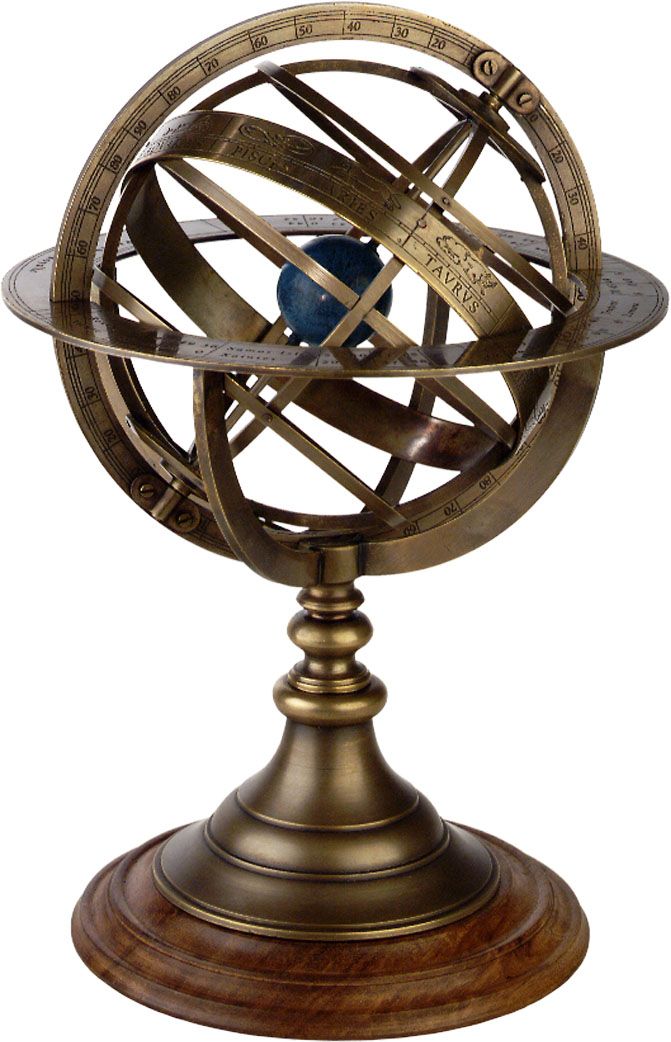
A guest post by HSCI 3013.002 students Danya Majeed, James Reeves and Crystal Neill.
History:
Imagine you are an astronomer in medieval times. You have studied Aristotelian physics. You wholeheartedly agree with Ptolemy’s description of the universe and have thoroughly digested the precepts laid out in his book, Almagest, detailing the position of the earth and the celestial bodies in the cosmos. But you, as an astronomer and aspiring astrologer, would like to use this knowledge for practical benefit. You want to devise a practical model of the theories laid forth by Ptolemy and therefore have decided to build a model of the universe based on his precise mathematical calculations.
This is how the Armillary Sphere was born.
Ptolemy himself provides instructions on how to build this model of the cosmos in Chapter 1, Book 5 of his opus magnum, Almagest. Who, among astronomers, was known to have actually built and used this instrument?
We know of three observatories in the Islamic world which used the armillary sphere. In the 13th century, the Maragha Observatory (modern-day Iran) used an armillary sphere. In the 15th century, the Samarkand Observatory (modern-day Uzbekistand) used an armillary sphere. In the 16th century, the Istanbul Observatory (modern-day Turkey) used an armillary sphere.
In the European world, the construction of the armillary sphere was taken from models found in Andalus (modern-day Spain). In the 16th century, well-known European astronomer Tycho Brahe constructed and used several armillary spheres. He built them of steel, brass, and wood held together by screws, in order to avoid warping materials which would render the instrument inaccurate. His armillary spheres were quite large, over 1.5 meters in diameter, and very accurate in their readings. Our good friend Copernicus also constructed armillary spheres in this time period, and gave rise to ideas which would lead to a different take on the instrument altogether.
In the 17th century, Copernicus’ heliocentric model of the cosmos had gained enough traction for armillary spheres to be constructed with the sun in the center instead of the Earth. These spheres also became more complex and astronomically accurate with the addition of rings for newly discovered planets, including Uranus and Neptune.

In the 18th century, the armillary sphere became a symbol of the well-read scholar. It can be found in paintings, manuscripts, and sculptures, representing the highly regarded and sought after science of astronomy as well as hinting at the polished and intellectual inclinations of the subject of the artwork. Books such as ‘The Young Gentleman and Lady’s Astronomy’ were published, describing the function of the armillary sphere as part of a leisurely educational curriculum for the upper class. The paintings “Allegory of the Arts” by Franscesco de Mura and A Young Princess by Jan Gossaert feature an armillary sphere, with the latter painting simply depicting a young girl holding the device in her hands.
The armillary sphere remains an emblem of scientific thought and an intellectual milestones in the history of science. In many ways, it represents the ingenuity and remarkably unmatched intelligence and perseverance of scientists throughout the centuries. Today, the Oxford Museum of Natural History holds an impressive statute of 13th century scientist Roger Bacon holding an armillary sphere in his hands, our own University of Oklahoma has two armillary spheres in its special History of Science collections, and Dr. Crowther even has a picture of one on the desk in her office.
How It Works:
This video describes the different parts: https://youtu.be/gBbZItACgyw
This video describes how to use it: https://youtu.be/pGNt_PKsNyY
Building:
This Armillary Sphere was made of laser cut particle board. We debated whether we should build the model out of wood, metal, or 3D print it, but we settled on cutting it from wood. Once we settled on a material and method of building, we then went through several different images and models to decide how to build it. The design we went with worked best with a solid stand that would allow the meridian to rotate between the horizon. Next, we used Adobe Illustrator to create the rings and print the cardinal directions and degrees, which was then cut or etched into the wood by the laser cutter. The pieces were fit together, and two nails were used to allow the globe and its parts to rotate. The Earth is a Styrofoam ball suspended by a wooden dowel. Once the pieces were cut, it was a matter of putting them together and making sure that the zodiac was in the correct orientation.

Further reading:

One thought on “Armillary Sphere”